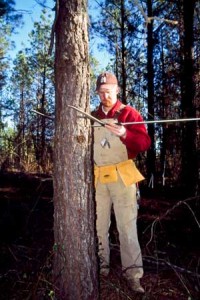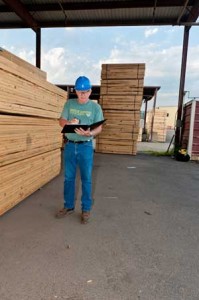 Log purchasers use many reasons for the differences in log rules. For example, users of the Doyle Rule, which underestimates volume in smaller logs, say that this is the very reason it is a fairer rule in that it costs them more to process smaller logs. This is logical since the logger will have to cut more trees, the sawyer will have to saw more logs, and the yard crew will have to move more logs to the sawyer, to equal the amount of lumber in much larger logs. However, if he cannot efficiently utilize smaller logs, he should base his offer on that, not on a biased estimation of yield. There are other reasons given to justify variance in log rule use, but frankly, none hold much water for me. As we can see, there is the potential for dishonesty when choosing log rules.
Log purchasers use many reasons for the differences in log rules. For example, users of the Doyle Rule, which underestimates volume in smaller logs, say that this is the very reason it is a fairer rule in that it costs them more to process smaller logs. This is logical since the logger will have to cut more trees, the sawyer will have to saw more logs, and the yard crew will have to move more logs to the sawyer, to equal the amount of lumber in much larger logs. However, if he cannot efficiently utilize smaller logs, he should base his offer on that, not on a biased estimation of yield. There are other reasons given to justify variance in log rule use, but frankly, none hold much water for me. As we can see, there is the potential for dishonesty when choosing log rules.
A completely different system presently being used across the country is weight scaling. In this system, logs are purchased for a set price per ton. It works out fairly we ll for species used for construction lumber like Southern yellow pine and spruce. It is particularly well suited for logs meant for paper pulp, in that quality, size, and species are really irrelevant in that market. However, it leaves a lot to be desired when pricing lumber from high value hardwoods. Having a set rate per ton completely disregards the quality of the log, although loads with obviously rotting logs and other gross defects are turned away. Hence, a seller of quality logs will receive an average price for above average timber.
ll for species used for construction lumber like Southern yellow pine and spruce. It is particularly well suited for logs meant for paper pulp, in that quality, size, and species are really irrelevant in that market. However, it leaves a lot to be desired when pricing lumber from high value hardwoods. Having a set rate per ton completely disregards the quality of the log, although loads with obviously rotting logs and other gross defects are turned away. Hence, a seller of quality logs will receive an average price for above average timber.
Henry Spelter wrote in “Converting among Log Scaling Methods” in the June, 2004 issue of the Journal of Forestry, “…log scaling, as traditionally practiced in the United States, is imprecise, inconsistent, and biased.” To protect yourself when selling logs from your woodlot, have a professional forester measure and seek bids for your logs. Using this method will more likely result in obtaining a price based on quality rather than some arbitrary log scale. Your sale will probably still rely on an estimate of board feet of lumber, but when bidding takes place, more realistic estimation takes place.  If a purchaser is buying a sale of smaller logs, he should not hide his inefficiencies within a log rule, but offer less if that is what he needs to do. Another buyer who has invested in modern equipment may be able to offer more for the same logs because she can more efficiently utilize smaller logs. Hence, the market will rule.
If a purchaser is buying a sale of smaller logs, he should not hide his inefficiencies within a log rule, but offer less if that is what he needs to do. Another buyer who has invested in modern equipment may be able to offer more for the same logs because she can more efficiently utilize smaller logs. Hence, the market will rule.
If you are buying a particularly nice log to have it sawn, try your best to pay based on the final yield. If you have to pay for it before you have it sawn, find out what the legal log rule is in your State, and use it for your basis to purchase the log. You will be less likely to end up paying for a log scaled in one log rule for the woodlot owner, and another for you.
Tim Knight






